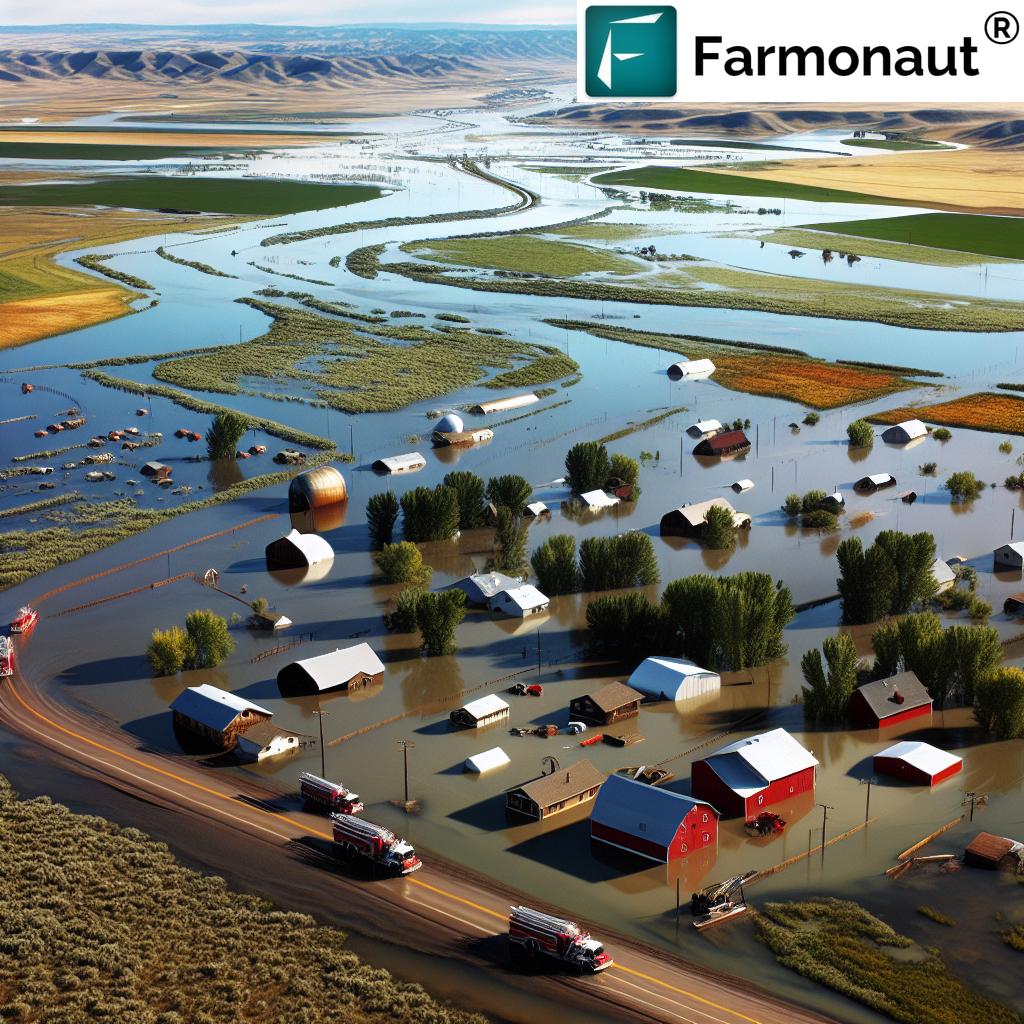Oregon Flood Emergency: Critical Response and Recovery Efforts in Harney County
“Oregon’s flood emergency in Harney County affects over 7,000 residents across 10,000 square miles of southeastern Oregon.”
As we face an unprecedented flood emergency in southeastern Oregon, our hearts go out to the residents of Harney County and the Burns Paiute Reservation. The rapid snowmelt combined with heavy precipitation has created a crisis that demands our immediate attention and coordinated action. In this comprehensive update, we’ll delve into the critical response and recovery efforts underway, highlighting the state’s commitment to protecting its citizens and environment during this natural disaster.
Understanding the Scope of the Oregon Flood Emergency
The severity of the flooding in Harney County and the Burns Paiute Reservation cannot be overstated. The combination of rapid snowmelt and continued precipitation has overwhelmed waterways and wastewater systems, leading to significant flooding that has disrupted daily life and posed serious threats to public health and safety.
- Roads, bridges, and culverts inundated
- Emergency services and essential operations disrupted
- Local commerce severely impacted
- Homes, businesses, and agricultural lands damaged
- Livestock areas affected
The scale of this disaster has prompted Governor Tina Kotek to declare a state of emergency, mobilizing resources and agencies to respond swiftly and effectively to the crisis.
State of Emergency Declaration and Immediate Response
On March 29, 2025, Governor Kotek took decisive action by declaring a state of emergency for Harney County and the Burns Paiute Reservation. This declaration is a crucial step in addressing the flood emergency and its impacts on local communities.
The Executive Order directs the Oregon Department of Emergency Management (OEM) to activate the State’s Comprehensive Emergency Management Plan (CEMP) and lead a coordinated, multi-agency response. This activation ensures that all available resources are mobilized to protect lives, property, and infrastructure.

Multi-Agency Coordination in Flood Response
The flood emergency has triggered a comprehensive response involving multiple state agencies, each playing a critical role in addressing various aspects of the crisis:
- Oregon Health Authority (OHA) and Department of Environmental Quality (DEQ): Addressing public health concerns, including hazardous materials and contaminants in floodwaters
- Oregon Department of Corrections (DOC): Deploying work crews for sandbagging efforts
- Oregon Department of Human Services (DHS-OREM): Actively engaged on the ground to provide humanitarian assistance
- Oregon Department of Agriculture (ODA): Assessing and addressing impacts on agricultural lands and livestock
- Oregon Department of Transportation (ODOT): Managing road closures and infrastructure repairs
- Oregon Water Resource Department (OWRD): Monitoring water levels and managing water resources
- Oregon Department of Forestry (ODF): Providing critical support to response operations
- Oregon State Fire Marshal (OSFM): Assisting with emergency response and coordination
This coordinated effort demonstrates the state’s commitment to a comprehensive and effective response to the flood emergency.
Public Health and Environmental Hazards
The flooding in Harney County and on the Burns Paiute Reservation has created serious public health and environmental hazards that require immediate attention. The Oregon Health Authority (OHA) and the Department of Environmental Quality (DEQ) are working tirelessly to address these concerns:
- Contaminated floodwaters pose risks of waterborne diseases
- Hazardous materials may have been released into the environment
- Damage to wastewater systems could lead to sewage contamination
- Potential for mold growth in flooded buildings
Residents are urged to follow all health advisories and avoid contact with floodwaters whenever possible. The OHA and DEQ are conducting regular water quality tests and providing guidance on safe water usage during this emergency.
Critical Infrastructure and Agricultural Impact
The flood emergency has had a significant impact on critical infrastructure and agricultural lands in southeastern Oregon. Roads, bridges, and culverts have been severely damaged, disrupting transportation and emergency services. The Oregon Department of Transportation (ODOT) is working around the clock to assess damage and implement temporary solutions to maintain essential routes.
Agricultural lands have been particularly hard hit, with many farms and ranches experiencing flooding and damage to crops and livestock areas. The Oregon Department of Agriculture (ODA) is coordinating with local farmers and ranchers to assess the extent of the damage and provide support for recovery efforts.
For farmers and agricultural businesses affected by the flooding, tools like Farmonaut’s carbon footprinting solution can be valuable in assessing and managing the environmental impact of recovery efforts. This technology can help track emissions and guide sustainable practices as the agricultural sector rebuilds.
Evacuation Procedures and Emergency Shelters
As floodwaters continue to rise in some areas, local authorities are working closely with state officials to manage evacuation procedures. Residents in high-risk areas are being urged to follow evacuation guidance and prepare emergency kits. The Oregon Department of Human Services (DHS-OREM) has established emergency shelters to provide safe havens for displaced residents.
- Follow all evacuation orders promptly
- Prepare a “go-kit” with essential items
- Stay informed through local news and the Oregon Flood Dashboard
- Check on neighbors, especially the elderly or those with mobility issues
“The Oregon Flood Dashboard provides real-time updates to over 100,000 Oregonians during the current flood emergency.”
Resource Management and Deployment
The State Emergency Coordination Center (ECC) has been activated to coordinate the deployment of resources across affected areas. This includes:
- Sandbag deliveries to critical locations
- Deployment of public information officers to ensure clear communication
- Mobilization of field staff to assess and respond to emerging needs
The Oregon Department of Forestry (ODF) and Oregon State Fire Marshal (OSFM) are providing additional support, leveraging their expertise in emergency response and resource management.
Innovative Technologies in Flood Response and Recovery
In addressing the challenges posed by this flood emergency, innovative technologies are playing a crucial role in response and recovery efforts. While not directly involved in the Oregon flood response, companies like Farmonaut offer solutions that could be valuable in similar situations:
- Satellite-Based Monitoring: Advanced satellite imagery can help assess flood extent and impact on agricultural lands.
- AI Advisory Systems: AI-driven tools can provide real-time insights and recommendations for flood management and crop recovery.
- Blockchain-Based Traceability: In the aftermath of flooding, ensuring the safety and origin of agricultural products becomes crucial. Blockchain-based traceability solutions can help maintain transparency in the supply chain, especially important for affected agricultural areas.
- Fleet and Resource Management: Efficient management of response vehicles and resources is critical during emergencies. Advanced fleet management tools can optimize the deployment of emergency vehicles and equipment.
These technologies demonstrate the potential for innovation to enhance disaster response and recovery efforts, providing valuable tools for decision-makers and responders on the ground.
Community Support and Volunteerism
In times of crisis, the spirit of community shines brightest. Across Harney County and the Burns Paiute Reservation, we’re seeing an outpouring of support from volunteers and community organizations. Here’s how the community is coming together:
- Local organizations are coordinating volunteer efforts for sandbagging and clean-up
- Community centers are serving as distribution points for emergency supplies
- Neighbors are helping neighbors, especially those who are elderly or have special needs
- Local businesses are donating supplies and resources to aid in the response
This collective effort is a testament to the resilience and solidarity of Oregonians in the face of adversity.
Economic Impact and Recovery Planning
The flooding in southeastern Oregon is not just an environmental crisis but also an economic one. The impact on local businesses, agriculture, and infrastructure will be felt for months, if not years, to come. As we focus on immediate response efforts, it’s crucial to begin planning for long-term recovery:
- Assessment of economic losses in agriculture, commerce, and tourism
- Development of recovery plans for affected businesses and farms
- Exploration of federal and state funding options for rebuilding
- Implementation of strategies to boost local economy post-flood
For agricultural businesses looking to rebuild and optimize their operations, solutions like large-scale farm management tools can provide valuable insights and efficiency improvements.

Environmental Restoration and Sustainability
As we look beyond the immediate crisis, the focus will shift to environmental restoration and implementing more sustainable practices to mitigate future flood risks. This includes:
- Restoration of natural floodplains and wetlands
- Implementation of green infrastructure to improve water absorption
- Reforestation efforts to prevent soil erosion
- Development of more resilient agricultural practices
These efforts align with broader sustainability goals and can help create a more resilient southeastern Oregon for future generations.
Public Information and Communication Strategies
Effective communication is crucial during a state of emergency. The Oregon Department of Emergency Management (OEM) has implemented a comprehensive communication strategy to keep the public informed:
- Regular updates through the Oregon Flood Dashboard
- Coordination with local media outlets for timely information dissemination
- Use of social media platforms for real-time updates and alerts
- Multilingual communication to ensure all community members are informed
Residents are encouraged to stay tuned to official channels and sign up for alerts at ORAlert.gov to receive the most up-to-date information.
Long-Term Flood Mitigation Strategies
As we navigate this current crisis, it’s essential to look ahead and develop long-term strategies to mitigate future flood risks. These strategies may include:
- Updating flood zone maps and land use regulations
- Investing in improved drainage systems and flood control infrastructure
- Developing early warning systems for rapid snowmelt and potential flooding
- Implementing stricter building codes in flood-prone areas
By taking a proactive approach to flood mitigation, we can work towards creating more resilient communities in southeastern Oregon.
Support for Affected Farmers and Ranchers
The agricultural community in Harney County and surrounding areas has been hit particularly hard by this flood emergency. To support farmers and ranchers in their recovery efforts, several initiatives are being put in place:
- Emergency loan programs for affected agricultural businesses
- Technical assistance for crop and livestock recovery
- Soil testing and land rehabilitation support
- Guidance on insurance claims and disaster relief applications
For farmers looking to rebuild and optimize their operations, tools like crop plantation and forest advisory services can provide valuable insights for recovery and future planning.
Mental Health and Community Resilience
The impact of a natural disaster extends beyond physical damage. It’s crucial to address the mental health needs of affected communities:
- Deployment of crisis counselors to affected areas
- Establishment of community support groups
- Resources for managing stress and anxiety during the recovery process
- Long-term mental health support planning
Building community resilience is key to recovering from this disaster and preparing for future challenges.
Technological Innovations in Disaster Response
As we continue to face environmental challenges, technological innovations play an increasingly important role in disaster response and recovery. While not directly involved in the Oregon flood response, companies like Farmonaut demonstrate the potential of technology in addressing agricultural and environmental issues:
- Satellite-based crop health monitoring for rapid assessment of flood impact on agriculture
- AI-driven advisory systems for optimizing recovery efforts in affected farmlands
- Blockchain-based traceability solutions to ensure food safety and supply chain integrity post-disaster
- Advanced weather forecasting and early warning systems for improved preparedness
These technologies showcase the potential for innovation to enhance our ability to respond to and recover from natural disasters effectively.
Coordination with Federal Agencies
The state of Oregon is working closely with federal agencies to maximize support and resources for flood-affected areas:
- Coordination with FEMA for disaster relief funding
- Collaboration with the U.S. Army Corps of Engineers for flood control measures
- Partnership with the USDA for agricultural disaster assistance
- Engagement with the EPA for environmental impact assessment and mitigation
This federal-state partnership is crucial for a comprehensive and effective response to the flood emergency.
Oregon Flood Emergency Response Overview
| Response Area | Lead Agency | Actions Taken | Status |
|---|---|---|---|
| Evacuation Procedures | OEM, Local Authorities | Implemented evacuation orders, established emergency shelters | Ongoing |
| Infrastructure Damage Assessment | ODOT | Assessing damage to roads, bridges, and culverts | In Progress |
| Public Health Measures | OHA, DEQ | Water quality testing, health advisories issued | Active |
| Environmental Hazard Management | DEQ, ODA | Monitoring contaminants, assessing agricultural impact | Ongoing |
| Emergency Resource Deployment | OEM, OSFM | Coordinating sandbag deliveries, mobilizing field staff | Active |
Estimated Values:
- Affected Population: 7,000+
- Area Under Flood Warning: 10,000 square miles
- Resources Deployed: 500+ personnel, 50+ emergency vehicles
Community Engagement and Volunteer Opportunities
The response to this flood emergency has been marked by an outpouring of community support. For those looking to contribute to the recovery efforts, there are several ways to get involved:
- Volunteer for sandbagging and clean-up efforts (contact local emergency management offices)
- Donate to reputable disaster relief organizations operating in the affected areas
- Offer temporary housing for displaced residents through official channels
- Participate in community meetings to stay informed and contribute to recovery planning
Your involvement can make a significant difference in the recovery and resilience of our communities.
Conclusion: Moving Forward Together
As we continue to navigate this challenging time, the resilience and unity of Oregonians shine through. The coordinated efforts of state agencies, local authorities, and community members demonstrate our collective strength in the face of adversity.
While the road to recovery may be long, we are committed to rebuilding stronger and more resilient communities. By leveraging innovative technologies, implementing sustainable practices, and working together, we can overcome this crisis and emerge better prepared for future challenges.
Stay informed, follow official guidance, and continue to support one another. Together, we will overcome this flood emergency and build a more resilient southeastern Oregon.
FAQ Section
Q: How long is the state of emergency expected to last?
A: The current declaration is effective through April 30, 2025, unless terminated or extended sooner based on evolving conditions.
Q: Where can I find the most up-to-date information on the flood situation?
A: The Oregon Flood Dashboard provides real-time updates. You can also sign up for alerts at ORAlert.gov.
Q: What should I do if I’m ordered to evacuate?
A: Follow evacuation orders immediately. Prepare a “go-kit” with essential items and follow guidance from local authorities on safe evacuation routes.
Q: How can I help if I’m not in the affected area?
A: Consider donating to reputable disaster relief organizations or volunteering through official channels once it’s safe to do so.
Q: What assistance is available for farmers and ranchers affected by the flooding?
A: Emergency loan programs, technical assistance for crop and livestock recovery, and guidance on insurance claims are available. Contact the Oregon Department of Agriculture for specific resources.
For agricultural businesses looking to rebuild and optimize their operations post-flood, consider exploring solutions like crop loan and insurance support services, which can provide valuable assistance in recovery and future planning.
Earn With Farmonaut: Affiliate Program
Earn 20% recurring commission with Farmonaut’s affiliate program by sharing your promo code and helping farmers save 10%. Onboard 10 Elite farmers monthly to earn a minimum of $148,000 annually—start now and grow your income!
Stay Connected with Farmonaut
While Farmonaut is not directly involved in the Oregon flood response, its innovative agricultural solutions can be valuable for farmers and agribusinesses in various situations, including post-disaster recovery. Explore Farmonaut’s offerings:
For developers interested in integrating agricultural data into their applications, check out the Farmonaut API and the detailed API Developer Docs.
As we continue to support the recovery efforts in southeastern Oregon, let’s remember that resilience comes not just from our immediate response, but from our long-term commitment to sustainable practices and innovative solutions in agriculture and environmental management.
















